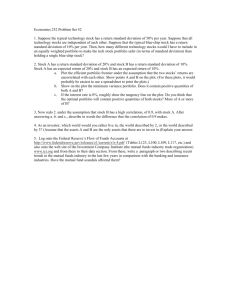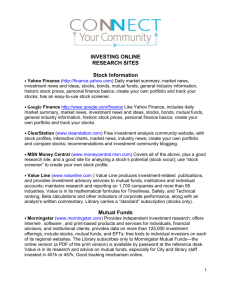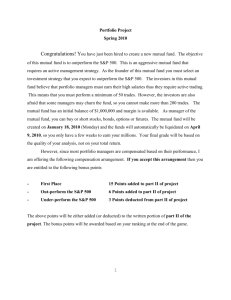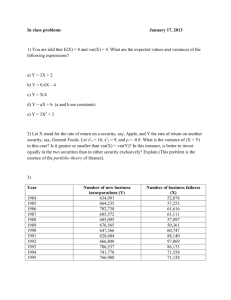Solution
advertisement
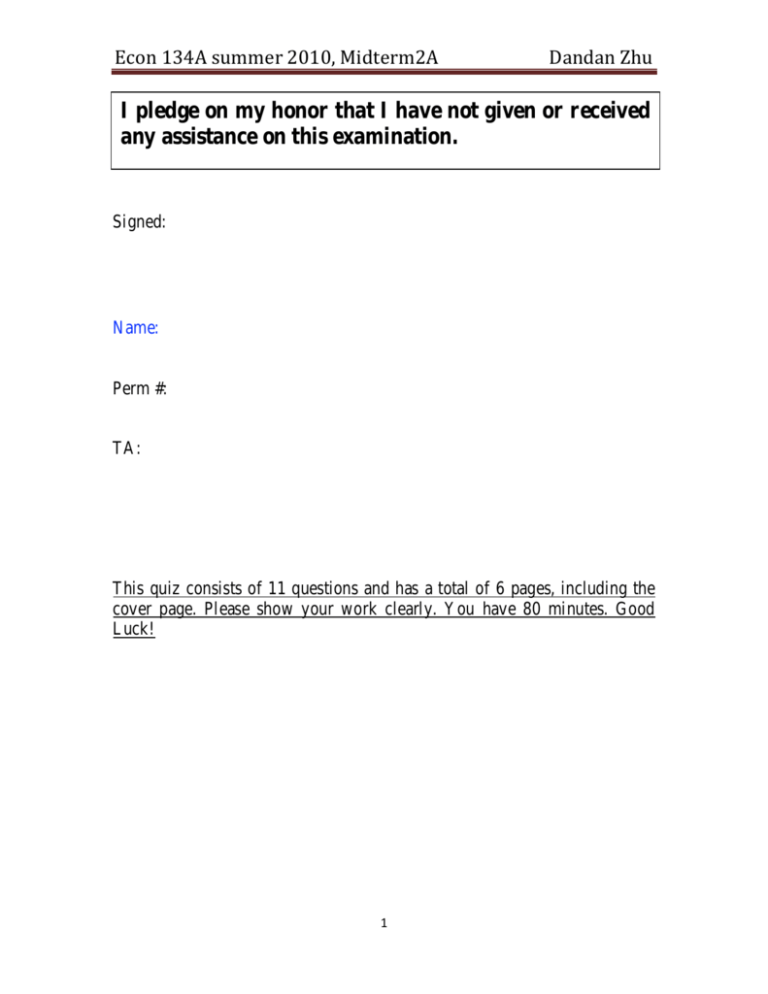
Econ 134A summer 2010, Midterm2A Dandan Zhu IIpledge have not not given given or or received received pledge on on my my honor honor that that II have any anyassistance assistanceon onthis thisexamination. examination. Signed: Name: Perm #: TA: This quiz consists of 11 questions and has a total of 6 pages, including the cover page. Please show your work clearly. You have 80 minutes. Good Luck! 1 Econ 134A summer 2010, Midterm2A Dandan Zhu 1. Which of the following statements are correct concerning the variance of the annual returns on an investment? I. The larger the variance, the more the actual returns tend to differ from the average return. II. The larger the variance, the larger the standard deviation. III. The larger the variance, the greater the risk of the investment. IV. The larger the variance, the higher the expected return. A. I and III only B. II, III, and IV only C. I, III, and IV only D. I, II, and III only E. I, II, III, and IV 2. One year ago, you purchased a stock at a price of $32 a share. Today, you sold the stock and realized a total return of 25%. Your capital gain was $6 a share. What was your dividend yield on this stock? A. 1.25% B. 3.75% C. 6.25% D. 18.75% E. 21.25% 3. A stock had returns of 8%, -2%, 4%, and 16% over the past four years. What is the standard deviation of this stock for the past four years? A. 6.3% B. 6.6% C. 7.1% D. 7.5% E. 7.9% 4. What are the arithmetic and geometric average returns for a stock with annual returns of 21%, 8%, -32%, 41%, and 5%? A. 5.6%; 8.6% B. 5.6%; 6.3% C. 8.6%; 5.6% D. 8.6%; 8.6% E. 8.6%; 6.3% 2 Econ 134A summer 2010, Midterm2A Dandan Zhu 5. You would like to combine a risky stock with a beta of 1.5 with U.S. Treasury bills in such a way that the risk level of the portfolio is equivalent to the risk level of the overall market. What percentage of the portfolio should be invested in Treasury bills? A. 25% B. 33% C. 50% D. 67% E. 75% 6. The market has an expected rate of return of 9.8%. The long-term government bond is expected to yield 4.5% and the U.S. Treasury bill is expected to yield 3.4%. The inflation rate is 3.1%. What is the market risk premium? A. 2.2% B. 3.3% C. 5.3% D. 6.4% E. 6.7% 7. What is the portfolio variance if 30% is invested in stock S and 70% is invested in stock T? A. .002220 B. .004056 C. .006224 D. .008080 E. .098000 8. The beta of a security provides an: A. estimate of the market risk premium. B. estimate of the slope of the Capital Market Line. C. estimate of the slope of the Security Market Line. D. estimate of the systematic risk of the security. E. None of the above. 3 Econ 134A summer 2010, Midterm2A Dandan Zhu 9. You have $1 million currently invested entirely in mutual fund A. You are considering switching into a combination of T-bills and mutual fund B for the next year. Mutual fund B is invested 50% in stock 1 and 50% in stock 2. A one year T-bill (zero coupon) with face value $10,000 is currently selling for $9523. You have come up with the following assessments of the return to mutual fund A along with the returns to stock 1 and 2 for the next year. E= ( RA ) 0.1, = σ A 0.2; E= ( R1 ) 0.1, = σ 1 0.2; = E ( R2 ) 0.18, = σ 2 0.3; Using just the T-bill and mutual fund B show how you ρ1,2 = 0.5 can construct an investment of your $1 million such that the portfolio is better than your current investment in mutual fund A. You must show clearly why the new portfolio is better and indicate the dollar investment in T-bills and mutual fund B. (6 points) Mutual fund B, E ( RB ) = 0.5(0.1) + (0.5)(0.18) = 0.14 Var ( RB ) = (0.5) 2 (0.2) 2 + (0.5) 2 (0.3) 2 + 2(0.5)(0.5)(0.5)(0.2)(0.3) = 0.0475 = σ ( RB ) = 0.0475 0.22 (2 points) 9523 = From T-bill, we can find risk-free rate, 10, 000 , rf 0.05 (1point), if we can = 1 + rf construct a portfolio of T-bills and mutual fund B, that has same expected return as mutual fund A, but smaller standard deviation, then the portfolio is better investment than mutual fund A. Set E ( R = wB (0.14) + (1 − wB )(0.05) = 0.1,= wB 0.56 p) Thus σ ( R = wB= σ B (0.56)(0.22) = 0.12 < σ A p) 4 (2 points) (1 point) Econ 134A summer 2010, Midterm2A Dandan Zhu 10. You are analyzing two stocks, let’s call them “Stock A” and “Stock B”. Based on current dividend yields and expected growth rates, the stocks are currently providing a return of 11% and 14% respectively. Also, the standard deviation on the returns of the two stocks is 10% and 11%. Your statistical analysis of both stocks revealed the betas to be 0.8 and 1.5 respectively. In addition to this information, you know that the return on the T-bill is currently 6% and the expected return of the S&P 500 Index is 12% (a) What’s your advice on stock A and B, to buy or to sell, why? (3 points) (b) Stock A is currently selling at $75 and stock B is selling at $60. Given that, at the current price, the dividend yield for both stocks is 5%, what would you expect the price of these stocks to be, one year from now, if the expected growth rate of dividends does not change?(4 points) (part b is a challenging question) (a) By CAPM, (1 point) E ( RA ) =R f + β A ( Rm − R f ) =6% + 0.8(12% − 6%) =10.8% < 11% E ( RB ) =R f + β B ( Rm − R f ) =6% + 1.5(12% − 6%) =15% > 14% Buy A, sell B. (2 points) (b) The formula you use to calculate price is p1 = Div2 , because you are asked the r−g expected price of stock, you should use expected rate of return as your discount rate, which comes from part (a). Next, you need to find the growth rate of dividends (assuming it doesn’t change). The total return on stock has two parts, current yield plus capital gain, and capital gain rate is equal to growth rate of dividends. Div Div1 r = 1 + g, g = r− p0 p0 current yield g A = 11% − 5% = 6% g B = 14% − 5% = 9% , notice we are using the realized return here. (1 point) = Div1 A $75(5%) = 3.75 = Div1B $60(5%) = 3 = p1 A , (1 point) Div1 A (1 + g A ) 3.75(1 + 0.06) = = $82.81 0.108 − 0.06 E ( RA ) − g A Div2 A (1 + g B ) 3(1 + 0.09) = = = $54.5 p2 A 0.15 − 0.09 E ( RB ) − g B 5 (2 points) Econ 134A summer 2010, Midterm2A Dandan Zhu 11. Jack's Construction Co. has 80,000 bonds outstanding that are selling at par value. Bonds with similar characteristics are yielding 8.5%. The company also has 4 million shares of common stock outstanding. The stock has a beta of 1.1 and sells for $40 a share. The U.S. Treasury bill is yielding 4% and the market risk premium is 8%. Jack's tax rate is 35%. What is Jack's weighted average cost of capital? (5 points) Re = .04 + (1.1 × .08) = .128 (1 point) Debt: 80,000 × $1,000 = $80m (1 point) Common: 4m × $40 = $160m (1 point) Total = $80m + $160m = $240m (2 points) 6 Econ 134A summer 2010, Midterm2A 7 Dandan Zhu
